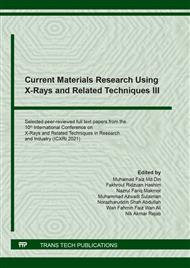p.86
p.92
p.105
p.110
p.119
p.125
p.130
p.135
p.141
Porous NiTi Shape Memory Alloy Fabricated via Powder Metallurgy Technique Using Pore Forming Agent
Abstract:
Porous NiTi shape memory alloy is of special interest for biomedical purposes especially for human bones application due to its attractive features such as lower stiffness to minimize the effect of stress shielding and good strength to prevent deformation and fracture apart from its shape memory effect and superelastic behavior. With all these great benefits, however, the challenge is to produce porous NiTi which resembles cancellous bone. Therefore, in this research, pore forming agent such as calcium hydride, CaH2, is added to the equiatomic of Ni and TiH2 powder mixture to produce porous NiTi with higher porosity level using powder metallurgy technique. Here, the effect of composition of pore forming agent on porosity level, phase formation and transformation behaviour of porous NiTi were investigated. From the observation, the pores formation exhibits small closed pores instead of interconnected pores. The result also shows that by adding 3wt% composition of pore forming agent, the porosity level of sample sintered can reach up to 32%. For phase transformation behavior, there are martensitic transformation peaks observed both upon cooling and heating for all samples, however the overall enthalpy changes are significantly lower (<2 J/g). This due to undesirable phase such NiTi2, Ni-rich phase and also Ni3Ti that co-exist with NiTi formation, thus jeopardize the transformation enthalpy for porous NiTi.
Info:
Periodical:
Pages:
119-124
Citation:
Online since:
January 2022
Price:
Сopyright:
© 2022 Trans Tech Publications Ltd. All Rights Reserved
Share:
Citation:


